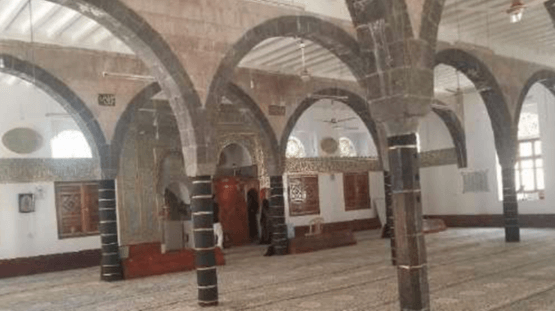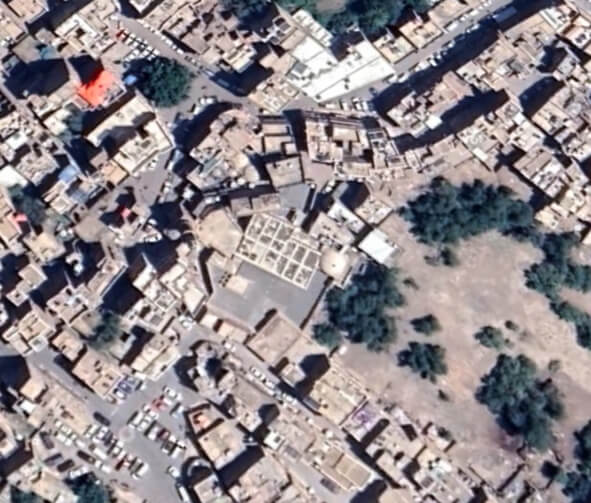
Al-Abzar Mosque – Old Ṣan‘ā’
مسجد الأبزر- صنعاء القديمة
Monument description
Farwah Mosque is one of the most ancient Mosques in the city, built during the era of the Prophet Mohammed, may Allah’s prayers and peace be upon him. It was built by the great companion of the Prophet, Farwa bin Mosayk Al-Muradi, who was one of the first companions to enter Sana’a, and some narrators attribute to him the construction of Sana’a Mosque.

Architectural and cultural value
Construction style and built date: The builder of the Mosque is the Prophet’s Companion Farwa bin Musayk, a Yemeni companion, believed to have been in Mecca during the 9th or 10th year of Islam. The Messenger promoted him on Murad, Madhhaj and Zabeid. The construction of the Mosque is dated to after the construction of the Great Mosque of Sana’a, approximately between the 6th and 8th year of Hejrah.
Components of the Mosque: The Mosque is divided into two parts. The old part: it is a semi-square shape Prayer Hall with a central dome attached to the hall. The hall has other facilities on the east and southeast sides, namely, what is known today as women’s Prayer Hall; the Minaret, that was built adjacent to the Prayer Hall from the western side; a well, no longer in use; a Mausoleum in the middle of the women’s chapel for Companion Farwa bin Musayk, and on the north side is the shrine of Imam Ahmed bin Ibrahim Al-Murtada. The modern part includes on the ground floor a Prayer Hall in addition to toilets, an open yard to the west, and rooms. A religious school was built on the first floor. Monument area: Old part: 410 m2. Modern part: 1,175 m2. Total area 1,585 m2.
- Justifications for intervention:
- 1 – Neglecting the competent authorities in carrying out periodic restoration work due to the lack of budgets for the repairs.
2 – Preserving the monument from disappearance and stopping the damage caused to the monument from expanding.
3 – Restoration of the damage to the mosque resulting from the flight strikes of the southern part of the old city of Sana’a.
- Monument conditions and treatments:
- Archaeological and architectural documentation reveal a number of damages in the Mosque, some of which are severe and threatening to the existence of the Mosque.
1. The central dome is damaged for the undulating cracks in the body of the dome. The cracks are accompanied by a significant leakage of moisture - 2. The renovation of the windows at the bottom of the dome, and their covering with Qamareah, led to the formation of joints between the plasterboards and the shoulders of the windows, which allowed rainwater to seep through the dividers into the interior
- 3. Cracks of the central dome were filled with cement, and, due to the heterogeneity of the cement with the Qudad, the cracks expanded and threaten a collapse of the dome
- 4. Due to thermal reflection during daylight hours, there is an increase of the thermal expansion in the eastern Prayer Hall, that led to cracking and separation of the sandstones.
- 5. The erosion of the stones of the walls and the rounding of their edges led to a drop in the levels of the walls, which contributed to the cracking of the roof, which in turn impacted the dome
- 6. The Prayer Hall was subjected to continuous renovations with paint, leading to the disappearance of the details on both the geometric and inscriptive bands
- 7. Work is needed to repair the distortion of the Tomb of the Great Companion Farwa. We envision the remotion of the sarcophagus and replacing it with a shrine built of cement blocks and covered with a wooden roof
- 8. The eastern façade of the northern Mausoleum dome is noticeably dented to the outside; undulating cracks appear above the door, and erosion of the wooden beams that replace the corner bent toward the interior — all this resulted in cracking of the domed ceiling and leakage of moisture to the interior, which led to the fall of the arch layers and an increase of the humidity level
- 9. The Minaret: it is the most unknown architectural element due to the thickness of the layers of paint covering the body, so we will not know its conditions until we remove the accumulated layers of paint
- 10. Water installations: Their condition is very bad because they have lost their actual function and became places for collecting various wastes. They need to be cleaned and rehabilitated.
- Treatments:
- – Removal and rebuilding the damaged parts of the Mosque using materials identical to the old materials (bricks, stones or others)
- – Removal of cement, cleaning the accumulated waste around the body of the dome and maintenance of cracks through fillings and covering them with Qudad latero Cleaning of the decorative inscriptions in the different parts of the Mosque; removing the oil paint, completing any dilapidated parts by deducing them from the decorations adjacent to them
- – Restoration of Qudad layers in the Mosque, especially in the dome, and completing the missing parts of ito Adjustment of the plaster boards around the windows and filling the spaces between them and the walls of the dome
- – Archaeological sounding are to be dug in north, western and southwestern corners of the Prayer Hall in the old Mosque, to see the relationship between the Mosque and the other parts
- – Remove the cabin covering the mausoleumo Ultraviolet restoration of the Mausoleum dome through the removing and reconstruction of all its parts
- – Removing the layers of oil paint from the Minaret, evaluate its condition and estimate a budget for the restoration
- – A complete rehabilitation of water facilities must be done.

Countries





